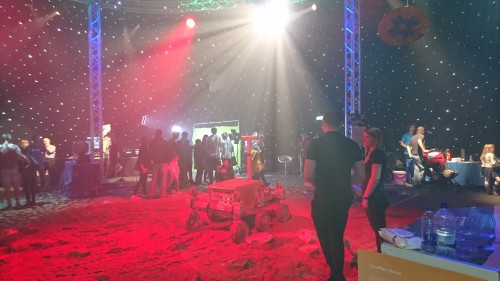
A prototype of the ExoMars rover trundles around inside the “space dome” at the Cheltenham Science Festival.
By Margaret Harris
How do you keep an astronaut alive, sane and (ideally) happy during a mission to Mars? The world’s space agencies would very much like to know the answer, but gathering data is tricky. The International Space Station (ISS) makes a good testbed for experiments on the physical effects of space travel, but psychologically speaking, ISS astronauts enjoy a huge advantage over their possible Mars-bound counterparts: if something goes badly wrong on the station, home is just a short Soyuz ride away. Martian astronauts, in contrast, will be on their own.
For this reason, space agencies have become interested in learning how people cope in extreme environments here on Earth, particularly in locations where rescue is not immediately possible. That’s why the European Space Agency (ESA) sent Beth Healey, a British medical doctor, to spend the winter of 2015 at Concordia Research Station, a remote base in the interior of Antarctica. During the continent’s nine-month-long winter, temperatures at Concordia can plunge as low as –80 °C, making it inaccessible even to aeroplanes, which cannot operate at temperatures below –50 °C. So once the last flight left in February 2015, Healey and the 12 other members of the overwintering team were stuck there until November.
Healey spoke about her experiences on Sunday as part of a panel on “Extreme Medicine” at the Cheltenham Science Festival. Joining her were two others with personal experience of extreme terrestrial environments: Edward Gilbert-Kawai, an intensive-care doctor who has studied climbers at Mount Everest Base Camp; and Kenton Cool, a climber and mountain guide who has summited Everest 12 times. The behaviour of human bodies at high altitudes interests ESA because it’s easier to build spacecraft if you can skimp a bit on oxygen and air pressure. (This is true of commercial aeroplanes, too: typical cabin pressure is roughly what you’d experience on Australia’s highest peak, the 2228 m Mount Kosciuszko.) Such stinginess has its drawbacks, though. As Gilbert-Kawai explained, even well-acclimatized humans do poorly on standard cognition tests above a certain altitude. Or, as Cool put it, “I was on the South Summit [of Everest], flat on my back, gasping for air like a dying kipper – but I still decided to continue.”
I caught up with Healey after the session finished and asked which aspects of extreme-environment survival she’d like to see studied in more detail. “There’s a lot more psychological research that needs to be done,” she said, adding that she’d like to see a greater focus on the qualitative experiences of people who’ve lived and worked in isolated environments, rather than just quantitative data about their blood pressure and suchlike. One thing that surprised her, she said, was how much the lack of daylight at Concordia affected her sleep patterns and appetite; also, during times of stress, members of the multinational crew tended to revert to their native languages, which made communication more difficult.
If the idea of sending sleep-deprived, cognitively impaired and poorly communicating humans to Mars strikes you as dubious, there’s an alternative: robots. The photo above shows a prototype of ESA’s ExoMars rover, which is being built by Airbus Defence and Space and is scheduled to launch in 2020. This vehicle will be semi-autonomous, and although the prototype wasn’t quite there yet – Daniel Erkel, a thermal engineer at Airbus, was driving it around Cheltenham’s “space dome” – the real thing should be a big improvement over the current generation of rovers. Before NASA’s Curiosity rover can move anywhere, Erkel explained, it has to wait many minutes for signals from its Earth-based drivers to arrive, but “once it [the new rover] goes up to Mars, it will be able to find its own route”, he says.
Later in the day at Cheltenham, I learned that robots are also rather good at another quintessentially human activity: gambling. In a session with the alluring title “How to Win at Poker”, physicist-by-training Robert Matthews explained that some artificial intelligence (AI) programs, or “bots”, have become so good at playing poker – and at hiding their true identities – that many online gambling sites now use bots to detect other bots. The result has been a kind of “Darwinian evolution” for bots, Matthews said, where the best poker-playing bots have learned to “simulate human foibles now and then” in order to avoid detection.
Live poker events are harder for AI to master, of course. But another panellist, champion poker player (and astrophysics graduate) Liv Boeree told the Cheltenham crowd that even when played face-to-face, poker is roughly “80% maths and 20% psychology”. Today’s very best poker players, she explained, are actually playing rather like machines – a strategy known as “game theory optimal” or GTO. Boeree went on to explain that GTO play requires sticking to a precise ratio of “value hands” (where your bets are based on the value of the cards you hold) and bluffing. That’s hard to do in a live game, and if you’re playing with someone weaker, it’s not even the best strategy, because pure GTO prevents you from taking advantage of their mistakes.
What sort of mistakes? Well, to begin with, “people grossly overestimate their ability to tell when others are bluffing, and underestimate the amount of information they are giving away with their bodies” observed the session’s third speaker, game theorist Andrew Colman. So if you find yourself passing the long hours of an Antarctic winter or a Mars mission with a few rounds of poker, remember: a “poker face” really does make a difference. Unless, of course, you’re playing with a robot.
Guidelines
Show/hide formatting guidelines
this text was deletedwhere people live in harmony with nature and animals</q>
Some text